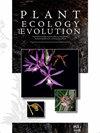热带褐藓科罕见的胎生现象——初报纤毛绵藓科
IF 1.3
4区 生物学
Q3 PLANT SCIENCES
引用次数: 0
摘要
背景和目的-被子植物中,据报道胎生现象在所有物种中所占比例不到0.1%。本文报道了非洲热带蜜豆科植物中首次出现的胎生果,并对其系统发育位置、习性、生境和果实特性进行了讨论。材料和方法:观测数据收集自对加蓬的野外考察,以及来自BR、BRLU、P和WAG的植物标本馆标本。建立了一套系统发育图,绘制了八种具有胎生性的植物。关键结果-纤毛Amphiblemma ciliatum是目前已知的唯一在非洲热带地区表现出胎生聚会的melastome物种。它棱角分明的蒴果很可能依靠雨水来传播种子。结论:在持续降雨和高湿的时期,在阴凉潮湿的热带雨林地板上生长的草性习性和角状果实可能是大多数褐花科植物产生生孢子的原因。本文章由计算机程序翻译,如有差异,请以英文原文为准。
Vivipary, a rare phenomenon in Afrotropical Melastomataceae: first report in Amphiblemma ciliatum (Sonerileae)
Background and aims – Within angiosperms, vivipary has been reported in less than 0.1% of all species. We herein report the first occurrence of vivipary in an Afrotropical Melastomataceae and discuss its phylogenetic position, habit, habitat, and fruit attributes. Material and methods – Observational data were gathered from a field expedition to Gabon, and from herbarium specimens from BR, BRLU, P, and WAG. A phylogeny was generated to map all the eight species exhibiting vivipary in Melastomataceae. Key results – Amphiblemma ciliatum is currently the only known melastome species in the Afrotropics exhibiting vivipary. It is likely that its angular capsules depend on rainwater for seed dispersal. Conclusion – The combination of a herbaceous habit and angular fruits with the occurrence on shaded humid tropical rainforest floor during periods of incessant rainfall and high humidity might be responsible for vivipary in most Melastomataceae.
求助全文
通过发布文献求助,成功后即可免费获取论文全文。
去求助
来源期刊

Plant Ecology and Evolution
PLANT SCIENCES-
CiteScore
2.20
自引率
9.10%
发文量
27
审稿时长
>12 weeks
期刊介绍:
Plant Ecology and Evolution is an international peer-reviewed journal devoted to ecology, phylogenetics and systematics of all ‘plant’ groups in the traditional sense (including algae, cyanobacteria, fungi, myxomycetes), also covering related fields.
The journal is published by Meise Botanic Garden and the Royal Botanical Society of Belgium.
 求助内容:
求助内容: 应助结果提醒方式:
应助结果提醒方式:


